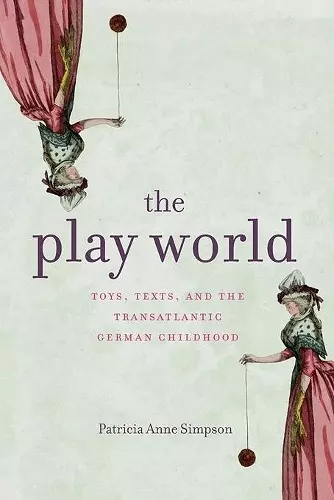The Play World
Toys, Texts, and the Transatlantic German Childhood
Format:Paperback
Publisher:Pennsylvania State University Press
Published:14th Mar '22
Currently unavailable, and unfortunately no date known when it will be back
This paperback is available in another edition too:
- Hardback£87.95(9780271086996)

This book examines the historical context of play and childhood, focusing on German influences and their impact on global perceptions. The Play World offers an interdisciplinary perspective.
In The Play World, Patricia Anne Simpson explores the historical and cultural evolution of play as an integral aspect of childhood. The narrative delves into various texts and toys produced in Europe from 1631 to 1914, highlighting how German material, literary, and pedagogical influences shaped contemporary notions of play and childhood across the transatlantic landscape. By examining the interplay between toys and the prescribed methods of play, Simpson reveals how these elements reflect broader societal values and expectations regarding childhood experiences.
Simpson meticulously analyzes the manufacturing and marketing of toys, alongside prescriptive texts that dictate how children should engage with their possessions and explore the world around them. The book presents an array of toys, including a mechanical guillotine and hybrid dolls, as historical agents that contribute to the shaping of childhood narratives. By employing an interdisciplinary framework that intersects postcolonial studies, childhood studies, and migration studies, The Play World argues that these toys and texts create a German-centric model of childhood that resonates globally.
This insightful study connects German-speaking communities across the Atlantic, revealing how they collaboratively construct the epistemology of play. It serves as an essential resource for scholars in German studies and those interested in the transatlantic exchange of cultural ideas related to childhood and play.
“A valuable intervention in the historiography of German childhood and play. Simpson’s argument has tremendous sweep: exploring changes in childhood and parenting over centuries, the role of play in child development, the deployment of racial and imperial images, the circulation of images and toys across the Atlantic, and the decline of German influence on images of childhood in the twentieth century.”
—David Hamlin German History
“The Play World is an engaging read with a compelling argument about the unique contribution of German arts and letters—through toys, children’s literature, and pedagogical texts—that offers a new understanding of the role of play in modern childhood.”
—Maureen O. Gallagher German Studies Review
“Simpson not only breaks ground for the critical study of the role of play and toys in the formation of modern German and American culture, paying special attention to the 18th and 19th centuries, but she also resists the lure of an easy narrative. Instead, her book reminds us how complicated, conflicted, and barely progressive this story of play and toys was.”
—Willi Goetschel The Germanic Review
“Simpson’s book is a welcome addition to discussions of the importance of the domestic sphere, and its artifacts and practices, for questions of cultural nationalism and transnational interplays. It shows the impact of toys and play on narratives of migration, the articulation of middle-class subjectivity, and the role of model childhoods in the self-identity of modern European family structures—and how they influenced European American family structures in their acquisition of racial, ethnic, and national regimes.”
—Karin A. Wurst, author of Fabricating Pleasure: Fashion, Entertainment, and Cultural Consumption in Germany, 1780–1830
“Within the burgeoning scholarship on play and the material culture of childhood, Simpson’s The Play World stands out through its attention to a breathtaking range of texts and artifacts that lie at the margins of the canon; its brilliantly eclectic methodology (combining literary, material, and intellectual history with postcolonial studies, critical race theory, gender studies, disability studies, and much more); and its ability to illuminate complex cultural and commercial currents that connect German-speaking Europe with Africa, Great Britain, and the Americas from the seventeenth century to WWI. It’s a remarkable book that will resonate within and beyond the field of childhood studies.”
—Elliott Schreiber, co-editor of Play in the Age of Goethe: Theories, Narratives, and Practices of Play around 1800
“[A] fascinating read for scholars of the transatlantic world, of Germany, and of parenting, and it importantly cements German imperialism not as a fact to be debated but as clearly constitutive of familial and (trans)national identities.”
—Amanda M. Brian H-Transnational German Studies
ISBN: 9780271087009
Dimensions: 229mm x 152mm x 22mm
Weight: 454g
312 pages